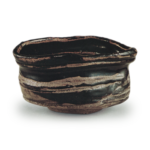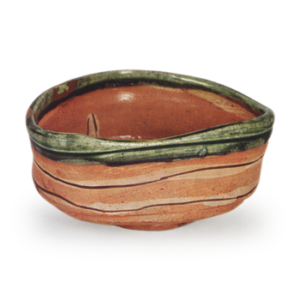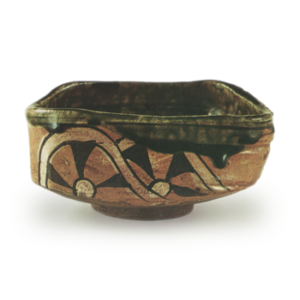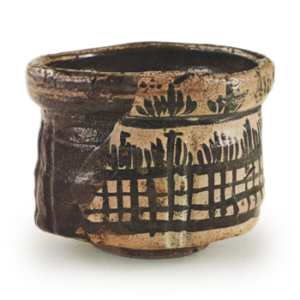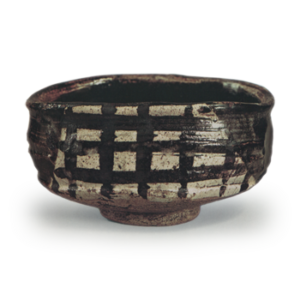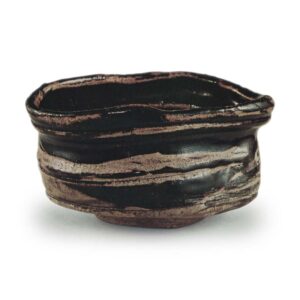
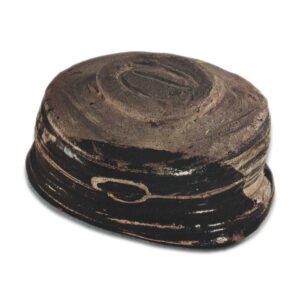
Height: 7.7 – 8.3 cm
Diameter: 10.2 – 15.7 cm
Outside diameter of foot ring: 6.0 – 7.0 cm
Height of foot ring: 0.6 – 1.0 cm
This is a famous Oribe bowl that is thought to have been made in the kiln of the former residence of Mino Hisajiri during the Keicho era. Although black glaze is applied almost entirely to the inside and outside, the part where the black glaze on the outside is left unpainted is covered with white glaze on top of the iron painting, so it is not Oribe black, but black Oribe.
The clay is a rough, egg-shell-colored moxa clay, and a slightly dull black glaze is applied to the inside and outside. On the inside, the black glaze is scraped off in thick lines to reveal the clay, and there are also places where the glaze has been scraped off with a spatula around the rim. The thick, two-line scraping of the black glaze on the outside of the body is extremely effective, and the free and unrestrained feeling comes alive.
On the reverse side, the outside of the body is decorated with a pattern of circles connected by lines, which is characteristic of Oribe ware, and the black glaze has been scraped off to reveal the pattern. The part of the glaze that has been left on is plain white on one side and has a rough horizontal striped pattern painted on it using iron pigment, and a transparent white glaze has been applied over this.
The shape is called “kutsu-gata” (shoe-shaped), and when viewed from above, the bowl is distorted into an oval shape. The rim is folded over and doubled, so it is unusually thick and undulates like waves. The body is almost straight, but low, and has a free-flowing potter’s wheel mark.
The foot ring was carved with a wooden spatula, and it is a rich, full-bodied piece. The artist’s signature is carved into the foot ring with a spatula. This is not a kiln mark like other tea bowls, but a symbol of the person who made this tea bowl. Pieces with foot ring signatures have been discovered in Okaya and Ohira Kachi, but it is not known who made them.
It is one of the most outstanding tea bowls in the Oribe style, which is known for its bold and powerful designs and modern sensibilities.
The box is made of paulownia wood with a black oak border, and on the front is the inscription “Shofu”, and on the back is the poem “The sound of the koto (Japanese harp) echoes through the mountains, and the path that leads to the peak of the mountain is never-changing”. There is a note attached by Sōchū that reads “Written by Sōchū on the 29th day of the 4th month of the 1st year of Bunkyū in the year of the fire rooster”, and it also says “The characters for ‘Shōfū’ were written by Ippanjūzaemon Masataka (the third son of Kobori Enshū), and Sōchū recorded this”.
The history of its ownership is unclear, but it is a treasured item that belonged to a certain person who was known for being the first person in the Osaka stock market to start collecting tea utensils.

